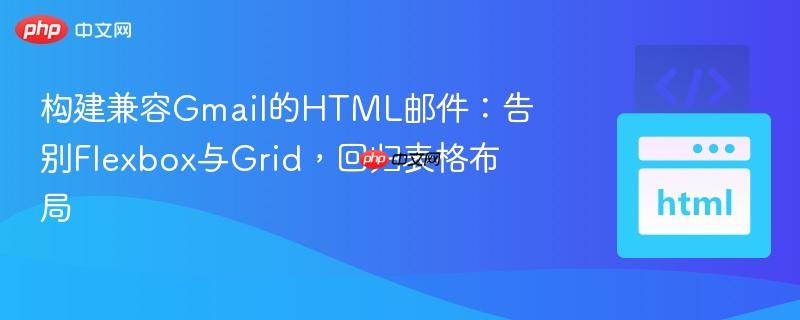
在现代web开发中,我们习惯于使用flexbox、css grid和响应式媒体查询来构建复杂且自适应的布局。然而,当这些技术被应用于html邮件时,开发者常会发现邮件在gmail等主流客户端中显示得一塌糊涂。这并非因为这些技术本身有问题,而是邮件客户端的渲染引擎与现代浏览器存在显著差异。
邮件客户端的渲染环境通常更为保守和碎片化,它们往往使用旧版浏览器引擎或自定义渲染器。例如,Gmail在某些情况下会剥离或忽略许多现代CSS属性。以下是导致布局混乱的主要原因:
为了确保HTML邮件在各种客户端(包括Gmail)中都能稳定显示,我们需要回归到更传统、更稳定的布局方法。
表格是构建邮件布局最可靠的方式。虽然在现代Web开发中不推荐使用表格进行布局,但在邮件领域,它们提供了跨客户端的高度兼容性。
由于邮件客户端可能剥离外部和嵌入式样式,将CSS直接写入HTML标签的style属性是确保样式生效最有效的方法。
立即学习“前端免费学习笔记(深入)”;
虽然媒体查询在某些客户端中有效,但考虑到其不一致性,应将其视为渐进增强的手段,而不是核心布局的依赖。
严格避免使用display: flex、display: grid、position: absolute/relative、float、calc()、transform、transition以及任何JavaScript。邮件客户端对这些技术几乎没有支持。
以下是一个简化的、兼容性强的HTML邮件结构示例,展示了如何使用表格进行布局和内联样式:
<!DOCTYPE html>
<html>
<head>
<meta charset="utf-8">
<meta http-equiv="X-UA-Compatible" content="IE=edge">
<meta name="viewport" content="width=device-width, initial-scale=1">
<title>您的邮件标题</title>
<!-- 嵌入式样式:作为内联样式的补充,某些客户端会支持 -->
<style type="text/css">
body {
margin: 0;
padding: 0;
background-color: #f6f6f6;
font-family: Arial, sans-serif;
-webkit-text-size-adjust: 100%;
-ms-text-size-adjust: 100%;
}
table {
border-spacing: 0;
border-collapse: collapse;
mso-table-lspace: 0pt;
mso-table-rspace: 0pt;
}
td {
padding: 0;
}
img {
border: 0;
outline: none;
text-decoration: none;
-ms-interpolation-mode: bicubic;
}
a {
text-decoration: none;
color: #007bff;
}
/* 媒体查询示例 (可能不被所有客户端支持) */
@media screen and (max-width: 600px) {
.email-container {
width: 100% !important;
}
.mobile-hide {
display: none !important;
}
.mobile-show {
display: block !important;
max-height: none !important;
overflow: visible !important;
}
.full-width-image img {
width: 100% !important;
height: auto !important;
}
}
</style>
</head>
<body style="margin: 0; padding: 0; background-color: #f6f6f6; font-family: Arial, sans-serif;">
<!-- 外部容器表格 -->
<table role="presentation" cellspacing="0" cellpadding="0" border="0" width="100%" style="background-color: #f6f6f6;">
<tr>
<td align="center" style="padding: 20px 0;">
<!-- 邮件主体容器表格 -->
<table role="presentation" cellspacing="0" cellpadding="0" border="0" width="600" class="email-container" style="background-color: #ffffff;">
<!-- 头部区域 -->
<tr>
<td style="padding: 20px; text-align: center;">
<img src="https://via.placeholder.com/150x50" alt="Logo" width="150" height="50" style="display: block; border: 0;">
</td>
</tr>
<!-- 主内容区域 -->
<tr>
<td style="padding: 20px;">
<h1 style="font-family: Arial, sans-serif; font-size: 24px; color: #333333; margin: 0 0 15px 0; text-align: center;">欢迎来到我们的邮件!</h1>
<p style="font-family: Arial, sans-serif; font-size: 16px; color: #555555; line-height: 22px; margin: 0 0 15px 0;">
感谢您的订阅。我们很高兴能与您分享最新资讯和独家优惠。
</p>
<!-- 按钮示例 -->
<table role="presentation" cellspacing="0" cellpadding="0" border="0" align="center" style="margin: 20px auto;">
<tr>
<td style="border-radius: 5px; background-color: #007bff; text-align: center;">
<a href="https://example.com" target="_blank" style="background-color: #007bff; border: 1px solid #007bff; font-family: Arial, sans-serif; font-size: 15px; line-height: 1.1; text-align: center; text-decoration: none; display: block; border-radius: 5px; font-weight: bold; padding: 10px 20px; color: #ffffff;">
点击查看更多
</a>
</td>
</tr>
</table>
<!-- 两列布局示例 -->
<table role="presentation" cellspacing="0" cellpadding="0" border="0" width="100%">
<tr>
<td width="50%" valign="top" class="mobile-full-width" style="padding-right: 10px;">
<h3 style="font-family: Arial, sans-serif; font-size: 18px; color: #333333; margin: 0 0 10px 0;">左侧内容</h3>
<p style="font-family: Arial, sans-serif; font-size: 14px; color: #555555; line-height: 20px; margin: 0;">
这是左侧栏的内容,可以放置图片或文本。
</p>
</td>
<td width="50%" valign="top" class="mobile-full-width" style="padding-left: 10px;">
<h3 style="font-family: Arial, sans-serif; font-size: 18px; color: #333333; margin: 0 0 10px 0;">右侧内容</h3>
<p style="font-family: Arial, sans-serif; font-size: 14px; color: #555555; line-height: 20px; margin: 0;">
这是右侧栏的内容,同样可以放置图片或文本。
</p>
</td>
</tr>
</table>
</td>
</tr>
<!-- 底部区域 -->
<tr>
<td style="padding: 20px; text-align: center; background-color: #eeeeee;">
<p style="font-family: Arial, sans-serif; font-size: 12px; color: #777777; margin: 0;">
© 2023 您的公司. 保留所有权利.
</p>
<p style="font-family: Arial, sans-serif; font-size: 12px; color: #777777; margin: 5px 0 0 0;">
<a href="#" style="color: #007bff;">取消订阅</a> | <a href="#" style="color: #007bff;">查看在线版本</a>
</p>
</td>
</tr>
</table>
</td>
</tr>
</table>
</body>
</html>在上述示例中:
HTML邮件开发是一项独特的挑战,它要求开发者暂时“忘记”现代Web开发的最佳实践,回归到更基础、更保守的HTML和CSS技术。通过采用表格布局和内联样式,并进行全面的跨客户端测试,可以最大限度地确保邮件在Gmail等各种客户端中呈现出一致且专业的视觉效果。记住,邮件设计的核心是兼容性和稳定性,而不是追求最新的Web技术。参考Cerberus等成熟的邮件模板库,可以帮助你更快地构建健壮的HTML邮件。
以上就是构建兼容Gmail的HTML邮件:告别Flexbox与Grid,回归表格布局的详细内容,更多请关注php中文网其它相关文章!

HTML怎么学习?HTML怎么入门?HTML在哪学?HTML怎么学才快?不用担心,这里为大家提供了HTML速学教程(入门课程),有需要的小伙伴保存下载就能学习啦!

Copyright 2014-2025 https://www.php.cn/ All Rights Reserved | php.cn | 湘ICP备2023035733号